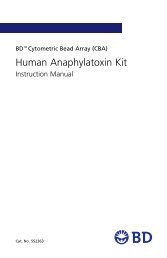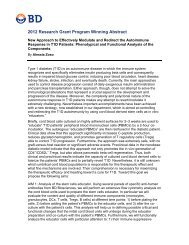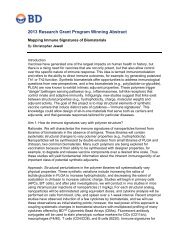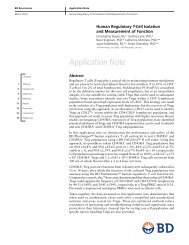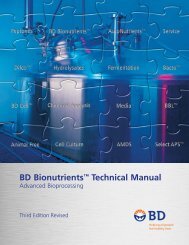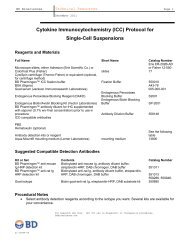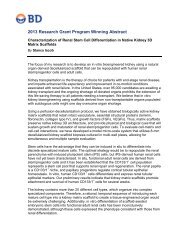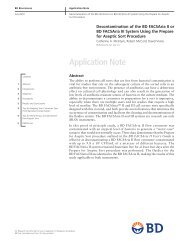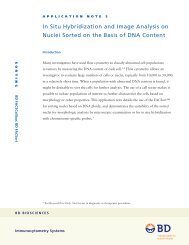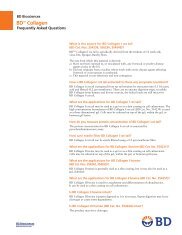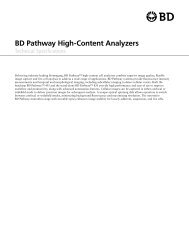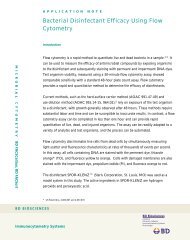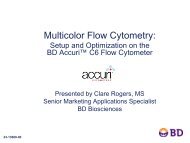TDS - BD Biosciences
TDS - BD Biosciences
TDS - BD Biosciences
Create successful ePaper yourself
Turn your PDF publications into a flip-book with our unique Google optimized e-Paper software.
Collecting Blood Samples<br />
Page 5 of 8<br />
(Version 030626)<br />
MicroFlow BASIC Kit (Mouse)<br />
Method: Collect mouse peripheral blood using a method approved by the Institutional Animal Care and Use<br />
Committee (IACUC). The tail vein is a common site for obtaining peripheral blood from a rat. The subsequent<br />
fixation procedure and micronucleus analysis is also effective for blood obtained from the orbital sinus or by cardiac<br />
puncture.<br />
Volume: Collect only 60–120 µl of blood (whether taking blood from the tail vein, orbital sinus, or heart) from each<br />
animal. It is important to obtain no more than 120 µl of blood since too much blood may compromise the flow<br />
cytometric analysis. It is also important that no debris be introduced into the sample.<br />
Anticoagulant: Use only Solution B as the anticoagulant; do not substitute a different anticoagulant. Collect drops of<br />
blood from the tail vein directly into tubes of Solution B. If a capillary tube or syringe is used to draw blood, pre-wet it<br />
with Solution B. Have extra tubes containing Solution B ready in case of a spill. Warning: Some capillary tubes<br />
include a clot activator that will cause aggregation and make the samples unanalyzable.<br />
1. Tubes containing 0.35 ml Solution B (anticoagulant) should be stored at 4°C until use. Approximately one hour<br />
before collecting blood, move these tubes to room temperature and maintain at room temperature throughout<br />
the blood collection procedure.<br />
2. For tail vein bleeding, place a mouse or group of mice (up to 5 animals) under a heat lamp (100 watt bulb<br />
placed 6 to 8 inches above the animals) for 5–10 minutes to dilate the tail veins.<br />
3. Shake the microcentrifuge tube immediately before bleeding each animal to coat the inside of the tube with<br />
Solution B.<br />
4. Make an incision in the tail vein using a sterile blade.<br />
5. Place the corresponding labeled tube of Solution B under the incision, and collect approximately three drops of<br />
blood (~120 µl). [Again, too much blood can be as great of a problem as not having enough. The volume of<br />
Solution B is appropriate for approximately three drops of blood. Varying from this amount may lead to samples<br />
which cannot be analyzed.]<br />
To prevent clotting, hold the tube so that the blood drops directly into Solution B and does not contact the side<br />
of the tube. It is important to make the incision such that the blood is free flowing, and falls directly into<br />
Solution B in a minimal amount of time (< 10 seconds). Apply moderate pressure to the wound with a laboratory<br />
tissue to stop the bleeding.<br />
6. Cap the tube and invert the tube several times to mix the blood with Solution B. The blood/Solution B mixture<br />
can be stored at room temperature for up to 6 hours before fixing.<br />
7. Repeat steps 3–6 for the remaining mice.<br />
Fixing Conditions<br />
It is extremely important that the tubes containing Solution A and fixed blood remain ultracold (–75 to –85 °C) and<br />
do not come in contact with vapors from dry ice. CO2 vapor causes carbonation and cellular aggregation. For this<br />
same reason, fixative should not be stored in a freezer containing dry ice, and fixation should not occur on dry ice.<br />
To avoid this problem, Solution A should be taken directly from the freezer.<br />
If you are unable to fix blood samples DIRECTLY from the –75 to –85 °C freezer as described in the Fixing<br />
Procedure, it is imperative that you do not fix the samples off dry ice under any circumstances without first calling<br />
Litron at (585) 442-0930 or sending an email to info@litronlabs.com. Litron will provide you with a detailed<br />
alternative fixing protocol. Without this alternative protocol, blood samples CANNOT be fixed appropriately and will<br />
be compromised, and flow cytometric analysis CANNOT be performed. Litron Laboratories is not responsible for<br />
samples prepared using a procedure other than the one described in this manual or supplied by Litron as an<br />
alternative.




